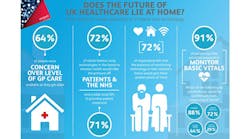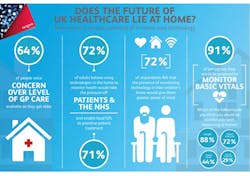This file type includes high resolution graphics and schematics when applicable.
We’ve already heard so much about the Internet of Things (IoT). It can, as you probably already know, tell us when we’re out of specific foods, and perhaps even order more without us realizing it.
The possibilities go far beyond fresh milk in the morning, though. This technology will inevitably change the world by revolutionizing transport, manufacturing, science, and healthcare, as we’ll demonstrate in more detail later on.
Sensory Overload
At the heart of this incredible network gradually being built around us, you’ll find a huge collection of simple yet massively useful sensors. They essentially act as the network’s ears and eyes, and use the data they collect to trigger certain actions from the hardware to which they’re connected.
The majority of these sensors come under the microelectromechanical-system (MEMS) technology bracket, and are manufactured through a lithography process. As they’re hardwired to perform basic and specific functions, they require minimal power and can last for 5 or 10 years without replacement—or in some cases, even longer.
They link the electronic world to our physical world, and are arguably the most integral part of the IoT revolution ahead.
Sensors in Healthcare
Although a sensor by itself is capable only of what it has been pre-programmed to do, the technology as a whole has so many different uses. The sensors are able to register changes in, for example, temperature, pressure, motion, sound, and light. They harvest this data and use it to instruct other connected hardware, triggering useful actions.
People often discuss the IoT’s commercial benefits, citing increased productivity in offices and on factory floors—and rightly so. But there’s another environment in which sensors can be (and already are) implemented to life-changing effect: healthcare. Below are a few prominent examples.
Connected pill boxes
It may seem trivial, but medication management is a major task in healthcare environments. Hospitals typically have thousands of patients, all on different types of medicine, and this all must be overseen carefully. In some cases, patients will be responsible for taking the correct doses at the right times, while in others, it’s down to staff. Either way, a slip-up or moment of forgetfulness can have serious consequences.
One solution is Memo Box. Much like a conventional pillbox, it separates medicine into days or times, helping patients keep track of their consumption. Here, though, Internet connectivity makes it possible for reminders and alerts to be sent through a smartphone. There’s even potential for it to trigger new prescription requests when necessary.
The sensors used can only tell if tablet has been removed, and not if it has been swallowed. However, with the capacity to learn about the user’s intake habits over time, it should eventually be able to make smarter decisions.
Intelligent walking aids
“Smart” walking aids sound like something from the future, but they have already been invented. In 2013, for example, Japanese tech giant Fujitsu created what it calls the Next Generation Cane –an intelligent walking stick that uses GPS, 3G, and Wi-Fi to help elderly and disabled people navigate their surroundings safely and quickly. The novelty satellite navigation features aside, this device can send an immediate alert if it thinks the user has fallen over, and is even able to monitor heart rate and temperature.
Implement similar technology into care home and hospital equipment and it becomes much easier for doctors to keep a close eye on their patients.
Environment monitoring
It’s crucial that healthcare providers afford all patients –especially the elderly—as much independence as possible. It’s for this reason that many residents of sheltered accommodation complexes and conventional care homes are left alone for much of the day. At present, though, there still has to be regular contact.
The IoT makes remote monitoring possible, which should help to increase feelings of independence among patients and residents. Motion sensors, for example, can tell whether someone has fallen, or if they’re struggling to move around. Staff can also be alerted to sudden temperature changes in a room. The appropriate fixes can then be actioned immediately with minimal disruption.
The Future is Bright
This really is just the beginning for the Internet of Things. The next steps will be to educate beneficiaries about its potential, and exactly what can be achieved.
It will take time to fully realize the technology’s capabilities. In healthcare, there’s scope for all kinds of amazing advances. We’re likely to see doctors carry out diagnosis procedures—and perhaps even more critical tasks—remotely, for instance. This could help to ensure that the time and expertise of medical specialists is used to maximum benefit.
It’s an exciting time for the IoT and all of the industries it’s likely to impact. The possibilities are truly endless.
Graeme Parton is a writer specializing in technology and working on behalf of Arqiva, an infrastructure and media services company. With a background in journalism and marketing, he’s covered everything from big data and business intelligence to cloud computing and the Internet of Things. Aside from writing about gadgets, Graeme enjoys live music and traveling to far-flung destinations.



